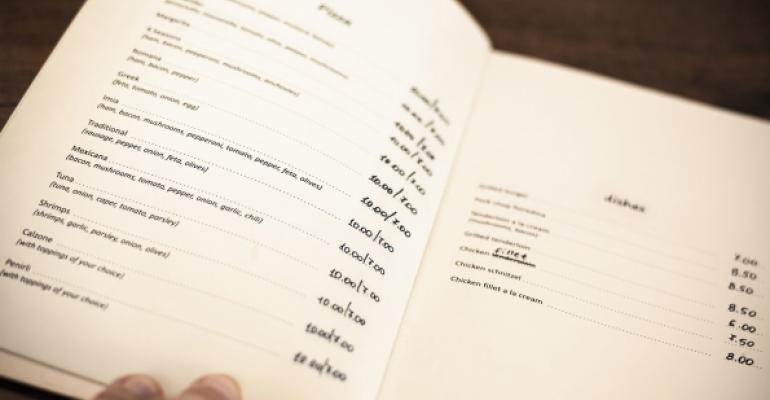Politics are clouding the future of nationwide menu labeling rules for restaurant brands with 20 or more units, even though they are set to go into effect in May.
President-elect Donald Trump and many in the Republican-led U.S. Congress have vowed to “repeal and replace” the Affordable Care Act, the passage of which called for the nationwide menu-labeling standard.
While menu labeling was mandated in the ACA, which could be repealed with a congressional budget reconciliation bill, its removal would require new legislation and a two-thirds vote of the U.S. House.
Menu labeling has drawn significant support, and its removal would be less likely.
The FDA’s compliance date, which the agency a few days earlier had said would be Dec. 1, added confusion to the menu-labeling timetable for restaurant compliance, said Betsy Craig, founder and CEO of Fort Collins, Colo.-based MenuTrinfo, consultancy.
“Our phone has been way active since Trump was elected,” Craig said in answer to emailed questions. “If the federal menu-labeling law is removed thanks to Trump, then that leaves folks in an even tougher place,” she said.
Meanwhile, the U.S. Food and Drug Administration on Friday clarified a deadline it issued earlier in the week and said it would extend the menu-labeling compliance date for the agency’s regulations to May 5, 2017, on restaurants with 20 or more units. That coincides with the rules’ enforcement date.
“The whole issue of labeling, which was confusing from the beginning, has just reach a quantum level of confusion,” said Marla Topliff, president of Elgin, Ill.-based Rosati’s Pizza.
“We sort of feel like we are on a rollercoaster ride with the logistics of trying to determine the rules for one core menu and how to efficiently present it,” Topliff said, adding that Rosati’s has been working on menu labeling for close to two years.
For Rosati’s nearly 200 restaurants in 17 states, she said, “the biggest issue has been conformity, continuity and presentation.”
Companies doing business in California were thrown “a curve ball” last week, she noted, when the FDA initially announced — and later clarified — the Dec. 1 compliance deadline. California has adopted the federal standard and its deadlines.
“This brought to light the fact that we may be dealing with the possibility of regional restrictions as well,” Topliff said.
“The idea of state-by-state regional restrictions as opposed to having one corporate core menu to prepare has the potential to be extremely costly and time consuming as well as way more confusing and difficult to prepare.”
Cicely Simpson, the National Restaurant Association’s executive vice president of government affairs, applauded the FDA’s clarification on the compliance and enforcement date, saying it gave “the foodservice industry the time it needs.”
“We have long-advocated for a nationwide federal menu-labeling standard,” Simpson said, “that gives customers access to uniform nutritional information at restaurants, that provides certainty to restaurateurs and foodservice operators over the patchwork of state and local laws.”
Uniform federal rules cleared up a problem for restaurant brands operating across a wide geographic area and various jurisdictions, Craig said. With local lawmakers enacting their own rules, the companies were facing a “patchwork” of menu-labeling laws, she said.
“Prior to Section 4205 of Obamacare,” she explained, “there were over 15 states, county, regional or city jurisdictions enacting and mandating menu-labeling rules. One of the biggest challenges is there was not a uniform nature to these various laws.
She noted that Philadelphia’s law mandated calories, transfat, saturated fat, sodium and carbohydrates be posted on the menu, but in California it was calories. In Philadelphia, the rules applied to brands with 15 units, she said, while in California, the rules applied to brands with 20 restaurants.
“Currently, some of our clients have very different looking menus based on their ZIP code,” Craig said. “That’s a challenge anyway you slice it for the corporation, creating heartburn for the director of operations for sure.”
“Brands that answer questions from consumers want as much put out there as possible,” she noted. “Transparency is the name of the game for folks today.”
“Even if Trump has his way with the federal mandate,” Craig added, “there is additional legislation in the wings.”
Still, Topliff noted that menu labeling benefits today’s health-focused consumers, may of which are asking for this information.
“The issue is not so much our taking the steps to get it done but the restrictions being placed on us on how best to present it to the public,” Topliff said.
“We are trying, but the constant changing of the rules and making the deadlines a moving target is not making it easy.”
Contact Ron Ruggless at [email protected]
Follow him on Twitter: @RonRuggless

